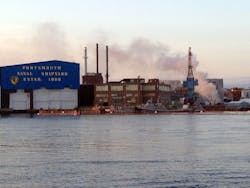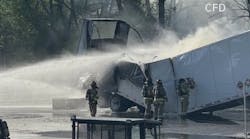The fire that raged through a nuclear submarine this spring at the Portsmouth Naval Shipyard in Kittery was deliberately set by a 24-year-old worker who told investigators he was suffering from anxiety and depression, according to Navy investigators.
The May 23 fire did $400 million in damage to the USS Miami and was fought by firefighters from three states.
Casey James Fury of Portsmouth appeared in federal court Monday and was told he faces up to life in prison if convicted of setting the fire to the sub, which was in the middle of a 20-month overhaul at the shipyard.
Fury was articulate and polite, clean-shaven and with medium-length hair at Monday's hearing. He wore orange jail clothing and handcuffs when he entered the courtroom. At one point he shared a chuckle with his court-appointed attorney.
Several family members attended the hearing, some of them crying periodically. They would not speak with the media.
Investigators with the Naval Criminal Investigative Service arrested Fury at the shipyard Friday night.
The arrest left shipyard workers bewildered.
"There is shock at the reality of the situation and the absurdity and the irrational reasoning of why those fires were started," said Paul O'Connor, president of the Metal Trades Council, which represents many of the workers at the yard.
"We're a community in the shipyard and we take our work seriously. For someone to be so reckless and callously irresponsible ... the actions just don't make sense and they never will to a rational human being."
Authorities initially said the fire appeared to have started in a vacuum cleaner found near where the fire originated.
But the incident prompted a massive inquiry into all aspects of the fire, which led shipyard workers to believe there was more to it, O'Connor said.
NCIS investigators apparently identified Fury as a suspect following a second fire June 16, according to an affidavit filed in U.S. District Court in Portland by NCIS Special Agent Jeremy Gauthier.
That fire, which was set among alcohol cleaning wipes placed on the dry dock scaffolding that supports the submarine, did little damage and the Navy said it appeared unrelated.
But another worker saw someone wearing green overalls and a hard hat near the area where the second fire started. Investigators interviewed people who had been working in that area, including Fury, who was employed as a painter and sandblaster.
He denied setting the smaller fire at the time, but was interviewed again last Wednesday and admitted setting it, the court papers said.
Fury told investigators that he had become anxious after texting his former girlfriend because he had come to believe that a man she was seeing was not merely a friend as she had claimed, the court papers said.
He told investigators he set the fire so he could leave work early. His mind was racing and he walked toward the rear of the boat, stuffed some alcohol wipes on the structure used to hold up the sub on the dry dock, and set fire to them.
During Wednesday's interview, Fury continued to deny setting the May 23 fire, which broke out in the area of a forward stateroom on the middle level of the ship and burned for 10 hours. Shipyard firefighters, submariners and firefighters from three states battled the blaze.
Firefighters were forced to enter the tight, blistering hot confines of the 360-foot submarine for short shifts to fight the blaze, battling smoke so dense they often couldn't see.
Nobody died, but seven people were injured. There were no weapons on board, the nuclear reactor was shut down and the propulsion area was not affected.
Fury had been working in the forward torpedo room, stripping paint with a tool on May 23, according to the court affidavit.
He initially told investigators he was alerted to the fire by a co-worker and saw billowing smoke as the two made their way up and out of the sub.
Investigators asked Fury to take a polygraph, which he did Friday, the court papers said.
When confronted with the results of the lie detector test, he admitted setting the May 23 fire as well, the court papers said.
"The reason he set the (May 23) fire was in order to get out of work," Gauthier said in his statement.
Fury said he initially lied about setting the fire because he was scared and "everything was blurry to him and his memory was impaired due to his anxiety and the medications he was taking at the time."
Fury walked investigators through the USS Pasadena, an identical Los Angeles attack submarine undergoing work at the shipyard, to show them step-by-step what he had done on May 23. He then did the same aboard the USS Miami.
Fury said he was working in a torpedo room in the forward part of the ship and was feeling extremely anxious.
He grabbed his cigarettes and a lighter and went up one flight of stairs to the staterooms.
There he set fire to some rags and left the room when the flames were two inches high, the court papers said.
A vacuum cleaner was on the bed near where he started the fire.
Fury had trouble remembering some details, describing the period as a blur during which he was intensely anxious.
He told authorities he was taking medicine for anxiety, depression, insomnia and allergies.
Days after the June 16 fire, Fury checked himself into an in-patient mental health facility for two days.
Fury is scheduled to be back in court Wednesday for a combined hearing to determine whether the government had probable cause to charge him and whether he should be released on bail.
U.S. District Court Judge John Rich III said the government can have Fury held for now.
"The government says there are no conditions of release that will ensure either your appearance or the safety of others in the community," Rich said.
As a sign of the case's significance, U.S. Attorney Thomas Delahanty II sat at the prosecutor's table and indicated afterward he will personally be involved in the prosecution along with Assistant U.S. Attorney Darcie McElwee and other assistant U.S. attorneys.
Fury faces two counts of arson in connection with the two fires. Delahanty said that arson is always a serious crime, with the possibility of death and serious injury, and the extent of damage to the submarine will not be a factor in determining Fury's guilt.
The Navy still has not said officially whether it will repair the Miami, at a cost of $250 million to $440 million, but O'Connor said he has been told it will be repaired at the Kittery shipyard.
However, the Navy is dealing with budget cuts and the possibility of even deeper, automatic cuts on Jan. 1 if Congress and the president can't reach agreement on deficit reduction, he said.
O'Connor said he does not know Fury or how long he had worked at the yard. He suspects Fury will spend a long time in prison.
"This one guy's irrational actions have had a negative impact on our national security," he said.
"How 'bout the men and women who risked their lives, whose lives were threatened by this reckless behavior?"
Copyright 2012 - Portland Press Herald, Maine
McClatchy-Tribune News Service






